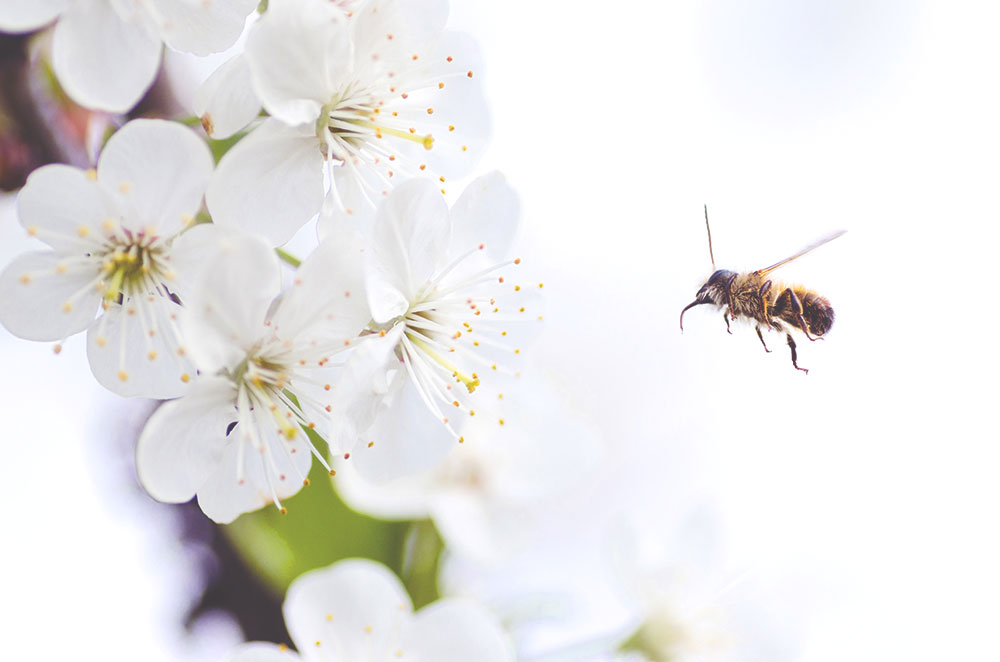It’s time to have a talk about “the birds and the bees.” Get to know what our busy friends are up to, and celebrate all that they do to help us stay alive.
BY: LINDSEY KANE, MS, RD, LDN
More and more people are beginning to make a conscious effort to show appreciation for where our food comes from and the hard work that goes into growing, raising, and harvesting it. From shopping locally, meeting local farmers, and learning about their farming practices, there’s no better time to get informed and educated on all the work that goes on to sustain our food supply.
But we often forget to give thanks to the unsung heroes: bees and their fellow pollinators.
Did you know that bees and other pollinators, including hummingbirds, are needed for more than two-thirds of the world’s crop species? In fact, one out of every three bites of food is pollinated by honeybees, bumblebees, hummingbirds, and monarch butterflies, as well as the hawk moth and the firefly.
Those are some busy birds and bees!
Because so much of our food crops’ future relies on our pollinators, it’s even more crucial than ever to know the following facts:
- Since 2006, U.S. honeybee colonies have been dying at an annual rate of 30 percent.
- Nearly 1/3 of America’s bumblebee species are now at-risk of extinction.
- Bees and other pollinators are needed for more than 100 crops in the U.S.
Imagine guacamole without avocados, onions, or tomatoes. Or your morning smoothie without any berries. With no tomatoes, you can say goodbye to marinara! And with no apples, you can say goodbye to apple pie.
In fact, a Whole Foods Market store in Berkeley, CA once removed all pollinator-dependent produce from the store’s salad bar to demonstrate what life could be like without pollinators. Only about 40 percent of the store’s original salad bar offerings remained. Though many of the foods affected are plant-based foods, our animal proteins and dairy products are also at risk since pollinators are vital to crops that feed cattle.
No pollinators = no feed for our animals = no meat and no dairy.
Most research points to a variety of factors for the decline, including loss of habitat (deforestation and decline in wildflowers), as well as toxic pesticides, and harmful parasites. Here’s how we can work together to put the world in a better state to pollinate:
1. Plant Seeds
Get into the gardening spirit and find your green thumb this spring by planting a pollinator-friendly garden.
2. Shop Organic
Organic plants, seeds, flowers, and produce limit the use of harmful pesticides, including neonics, which have been linked as one of the many variables associated with our decline in pollinators.
3. Support food products that are responsibly grown.
Look for and purchase products that have been vetted for sustainable practices. For example, Responsibly Grown is a rating system created by Whole Foods Market that rewards farmers who work hard to protect human health and the environment. Among other things, the system rewards farms for protecting wildlife—including pollinators The rating system provides shoppers with an at-a-glance “Good”, “Better”, “Best” rating system for sustainable farming practices.
By purchasing produce and flowers rated “Best” you are supporting farmers who protect pollinators by planting “bee-friendly” wildflowers, improving conservation areas and taking steps to protect beneficial insects from harmful chemicals.
4. ‘Bee’ Appreciative.
Ask questions about your food, where it comes from, and how it’s grown. Be thoughtful about your food choices, how much you really need when you buy, and practice mindful eating. Slow down, embrace each meal, give thanks, and pay respect for the food in front of you.
Do this, and you will find yourself making informed food decisions that are healthier for you, and the environment.
Adapted from the original article.
HEADER IMAGE: LUKAS BLAZEK
Lindsey Kane, MS, RD, LDN is a San Francisco-based Registered Dietitian helping others live a stress-free, balanced, and thriving life. By getting to know her clients inside and out, Lindsey identifies the opportunities within their everyday lifestyle to integrate subtle changes that create lasting, impactful results. Learn more at Bite For Change!

